
eBook - ePub
The Artistic Anatomy of Trees
Rex V. Cole
This is a test
Compartir libro
- 416 páginas
- English
- ePUB (apto para móviles)
- Disponible en iOS y Android
eBook - ePub
The Artistic Anatomy of Trees
Rex V. Cole
Detalles del libro
Vista previa del libro
Índice
Citas
Información del libro
`Monumental book . . . Mr. Vicat Cole is a born teacher.` — Contemporary Review
`Mr. Vicat Cole's ability as a landscape painter is well known, and he unites to his executive talents the qualifications of an accomplished teacher.` — Connoisseur
`The name of the author is itself a guarantee that the subject is adequately treated. It is handled in a systematic and lucid way, which the novice . . . can follow with ease.` — Studio
For years greatly admired and widely used, this excellent text by one of Britain's foremost art instructors has achieved the status of a classic in its field. The author, also a noted landscape painter, offers complete and accurate instruction in painting and drawing trees to all serious artists — beginner or advanced, amateur or professional. Its extremely comprehensive and detailed coverage has earned this volume a permanent place in the libraries of landscape painters, students, and teachers.
Every aspect of trees and how to depict them — in any style — is covered with unusual clarity and precision; problems of balancing tree groups, relations of light and shade, delicacy and weight, distance, sky apertures and their patterns, curves and straight lines in tree branches, tree color, the influence of special environmental factors (age, frost and snow, wind, moonlight), the effects of bud arrangements on the anatomy of trees, etc. Of special value is the very thorough and lucid analysis of tree anatomy: the proportion of boughs, branches, and twigs; the positioning of leaves on twigs; the form, texture, and color of leaves; leaf patterns; flower arrangement; stipules, bracts, buds, scales, spines, seedlings, the bark, and all the other essential details of structure. Specific information is given for each tree discussed: oaks, sycamores, willows, pines, maples, etc.; abstract and inaccurate generalizations are avoided. Nearly 500 illustrations by the author accompany the text, demonstrating all the anatomical features discussed. In addition, there are 48 full-page plates: magnificent landscape paintings and drawings by Giorgione, Rubens, Rembrandt, Van der Neer, Watteau, Hobbema, Turner, Gainsborough, Dupré, and many others, showing their compositional use of trees, their details in rendering, and similar material.
`Mr. Vicat Cole's ability as a landscape painter is well known, and he unites to his executive talents the qualifications of an accomplished teacher.` — Connoisseur
`The name of the author is itself a guarantee that the subject is adequately treated. It is handled in a systematic and lucid way, which the novice . . . can follow with ease.` — Studio
For years greatly admired and widely used, this excellent text by one of Britain's foremost art instructors has achieved the status of a classic in its field. The author, also a noted landscape painter, offers complete and accurate instruction in painting and drawing trees to all serious artists — beginner or advanced, amateur or professional. Its extremely comprehensive and detailed coverage has earned this volume a permanent place in the libraries of landscape painters, students, and teachers.
Every aspect of trees and how to depict them — in any style — is covered with unusual clarity and precision; problems of balancing tree groups, relations of light and shade, delicacy and weight, distance, sky apertures and their patterns, curves and straight lines in tree branches, tree color, the influence of special environmental factors (age, frost and snow, wind, moonlight), the effects of bud arrangements on the anatomy of trees, etc. Of special value is the very thorough and lucid analysis of tree anatomy: the proportion of boughs, branches, and twigs; the positioning of leaves on twigs; the form, texture, and color of leaves; leaf patterns; flower arrangement; stipules, bracts, buds, scales, spines, seedlings, the bark, and all the other essential details of structure. Specific information is given for each tree discussed: oaks, sycamores, willows, pines, maples, etc.; abstract and inaccurate generalizations are avoided. Nearly 500 illustrations by the author accompany the text, demonstrating all the anatomical features discussed. In addition, there are 48 full-page plates: magnificent landscape paintings and drawings by Giorgione, Rubens, Rembrandt, Van der Neer, Watteau, Hobbema, Turner, Gainsborough, Dupré, and many others, showing their compositional use of trees, their details in rendering, and similar material.
Preguntas frecuentes
¿Cómo cancelo mi suscripción?
¿Cómo descargo los libros?
Por el momento, todos nuestros libros ePub adaptables a dispositivos móviles se pueden descargar a través de la aplicación. La mayor parte de nuestros PDF también se puede descargar y ya estamos trabajando para que el resto también sea descargable. Obtén más información aquí.
¿En qué se diferencian los planes de precios?
Ambos planes te permiten acceder por completo a la biblioteca y a todas las funciones de Perlego. Las únicas diferencias son el precio y el período de suscripción: con el plan anual ahorrarás en torno a un 30 % en comparación con 12 meses de un plan mensual.
¿Qué es Perlego?
Somos un servicio de suscripción de libros de texto en línea que te permite acceder a toda una biblioteca en línea por menos de lo que cuesta un libro al mes. Con más de un millón de libros sobre más de 1000 categorías, ¡tenemos todo lo que necesitas! Obtén más información aquí.
¿Perlego ofrece la función de texto a voz?
Busca el símbolo de lectura en voz alta en tu próximo libro para ver si puedes escucharlo. La herramienta de lectura en voz alta lee el texto en voz alta por ti, resaltando el texto a medida que se lee. Puedes pausarla, acelerarla y ralentizarla. Obtén más información aquí.
¿Es The Artistic Anatomy of Trees un PDF/ePUB en línea?
Sí, puedes acceder a The Artistic Anatomy of Trees de Rex V. Cole en formato PDF o ePUB, así como a otros libros populares de Kunst y Kunsttechniken. Tenemos más de un millón de libros disponibles en nuestro catálogo para que explores.
Información
Categoría
KunstCategoría
KunsttechnikenPART I
TREES CONSIDERED IN RELATION TO PAINTING

BLAIR ATHOL (LTBER STUDIORUM). J. M. W. TURNER, R.A.
CHAPTER I
THE PAINTING OF TREES ILLUSTRATED BY A CHRONOLOGICAL SERIES OF PICTURES, WITH SOME DESCRIPTIVE NOTES
THÉODORE ROUSSEAU was able, in the painting of a single tree, to impress us with the greatness of nature—with her very soul, if one may use the expression. In looking at his tree we are not disturbed by wondering whether it is an Oak or an Ash or botanically correct. We are content to look at it and come away, feeling that we have seen something grand and without a wish to analyse it. Sometimes out of doors we may see a tree which will excite the same feeling; but genius is given to few, and any attempt to depict on canvas the feeling we experience, unless it is backed up by a knowledge of construction, results in flabbiness—as is too often seen in the imitators of Corot. We cannot see with other men’s eyes, but we can study what they look for. By some our tree will be shown to us as a mere outline, but even that alone can express the severity or rhythm of its lines—lines that would give us pleasure in anything, but here give us the grace, dignity, or strength, as it may be, of the particular tree. Others will wish us to appreciate the tree as a bulk, and will accentuate its statuesque quality in which all details are submerged. Others, again, will find out wonderful shapes, and through them will appeal to our love of pattern, successfully as they extract its complete structure and intricacy of detail.
Constable painted his leaves with the real light of the sky upon them, and they had a rugged homeliness about them free from all convention.
Turner, with a larger view, and strengthened with his absolute knowledge of their construction, used trees at will, weaving magnificent compositions with them as in his “Cephalus and Procris” and “Near Blair Athol” of the Liber Studiorum (Plate II). He utilised them for every device at the command of art; in one place as bits of light or dark, in another as links between single forms; here as a piece of delicate leaf tracery like lace work seen against the sky, there as massed spaces of heavy foliage leading into the gloom. Sometimes his tree was a portrait, at others a specimen of the type—often a type evolved from many species—simply a tree—but nevertheless a possible tree. Whether it was the subtle undulations of the foliage or the severity of the lines of the trunks, he had a use for them. To him nothing came amiss; his sunlight shimmered on the leaves or poured through the in broad shafts of light; his branches stretched out from the trunk mixing in the blue of the sky: no detail was too trivial to make note of, not even the seams or the roughness of the bark or the single leaves and twigs that he drew so well.1
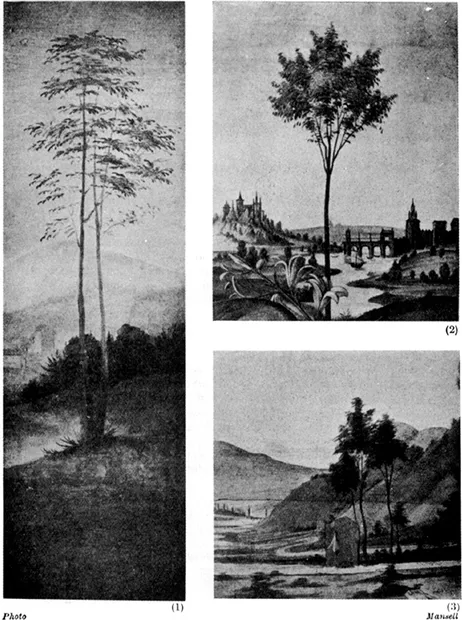
ILLUS. 1. PHOTOGRAPHS FROM PORTIONS OF THE PICTURES(1) VIRGIN AND CHILD AND THE INFANT ST. JOHN—Fra Bartolomeo(2) L’ANNUNZIAZIONE—Botticelli(3) VENUS AND CUPIDS—Sellaio
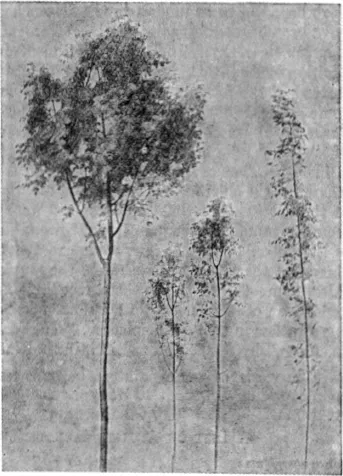
ILLUS. 2. A SKETCH OF SOME YOUNG TREES
Notice the likeness between the one on the left and Botticelli’s tree
From Titian and Patinier, the Fathers of landscape painting, to Cecil Lawson, we recall the names of those who have treated trees each in his own individual way. Titian, Giorgionc, Rubens, Claude, Rembrandt, Poussin, Salvator Rosa, Hobbema, Wilson, Gainsborough, Crome, Girtin, Turner, Constable, Cotman, Cox, Corot, Creswick, Diaz, Troyon, Müller, Rousseau, Daubigny, Monticelli, Cecil Lawson. To discuss adequately their points of view and their methods would require another book by another pen, but just to name them seems to brighten our minds and stir us to effort.
But our list should start with the Primitive Italians with their precise and delightful little trees painted in such an ingenuous way
with an infinite loving care. Their desire for an art, as something separate and different from ordinary life, seems to have guided them in the selection of just those trees that would satisfy it completely. Their trees were not, as some suppose, thought out formally, but were truthful copies of such as we find in our own copses to-day in the young trees that have been spared after the cropping of the underwood.
Here are three of them sketched the other day—just such as might have been taken as models in the fifteenth century, when they would have been beautifully painted; leaf after leaf standing out dark against a sweet clear sky. Their appreciation of delicacy, and the nice disposition of the little blocks of foliage up the stem might well be followed, instead of the formality in untruthful ugliness that is conjured up by some of our illustrators to-day. Another form is a compact and dense little tree covered with separate leaves as in the background of “The Virgin adoring the Infant Christ” by Lorenzo di Credi (Illus. 3). They are delightful, though in truth they resemble shrubs. These are the chief forms of trees that are associated with the paintings of that period, but that other aspects were also used then is evident from Giovanni Bellini’s painting of a wood in the picture, “The Death of St. Peter, Martyr.” The same exactness in copying the leaves is there, but the wood has depth, and the trunks give out branches on all sides, some towards us, others receding into the wood. The same veneration of nature even in her details is shown in the realistic painting of a lemon tree in the picture, “The Madonna, Infant Christ, and St. Anne,” by Girolamo dai Libri, in the National Gallery.
The work of some painters becomes more interesting if we remember when it was that they lived. Here is a list of those we mention:
A LIST OF ARTISTS MENTIONED IN THE TEXT

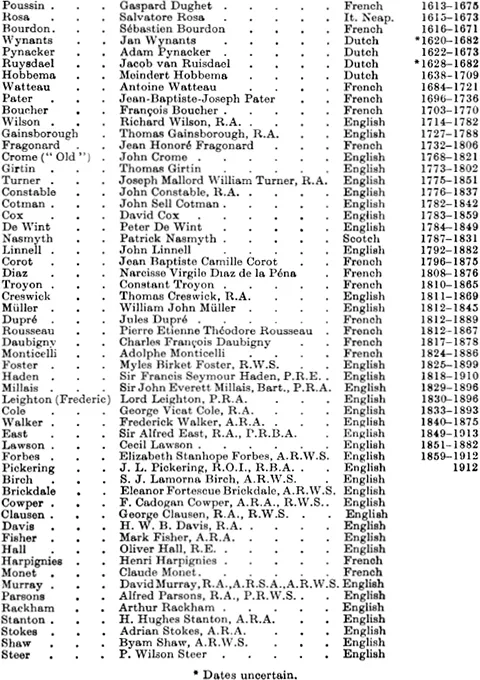

ILLUS. 3. TREES IN “THE VIRGIN ADORING THE INFANT CHRIST,” BY CREDI
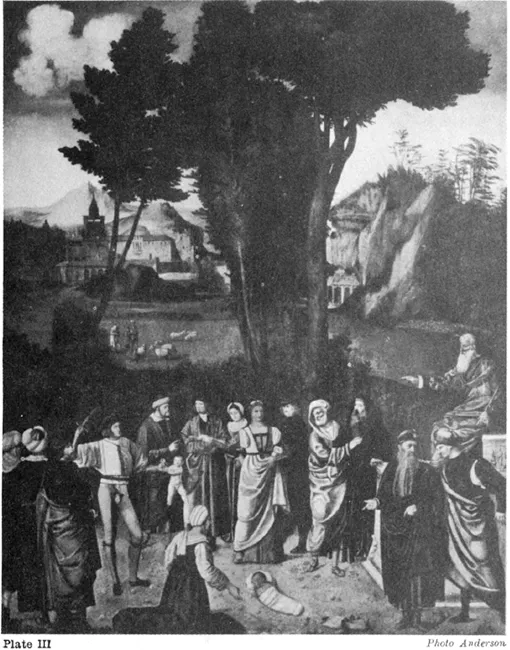
JUDGMENT OF SOLOMON. GIORGIONE (UFFIZI GALLERY)
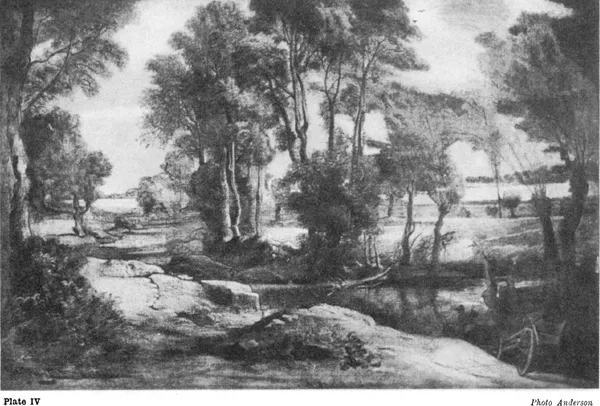
LANDSCAPE. RUBENS (NATIONAL GALLERY)
Notice how modern this beautiful landscape looks, and the shapes of the sky spaces.

A DRAWING IN THE BRITISH MUSEUM BY “GUERCINO” (BARBIERI)
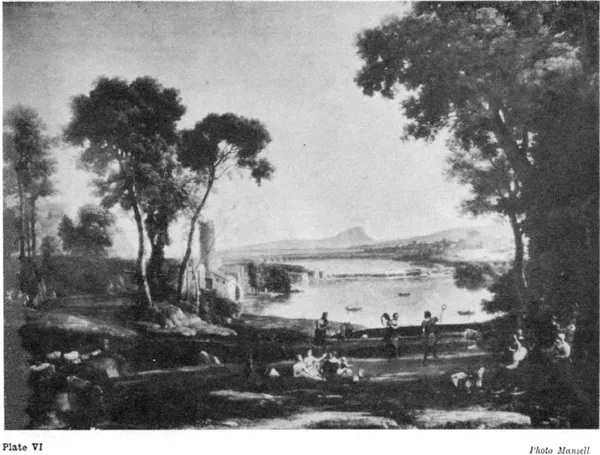
MARRIAGE O ISAAC AND REBECCA. CLAUDE LORRAINE (NATIONAL GALLERY)
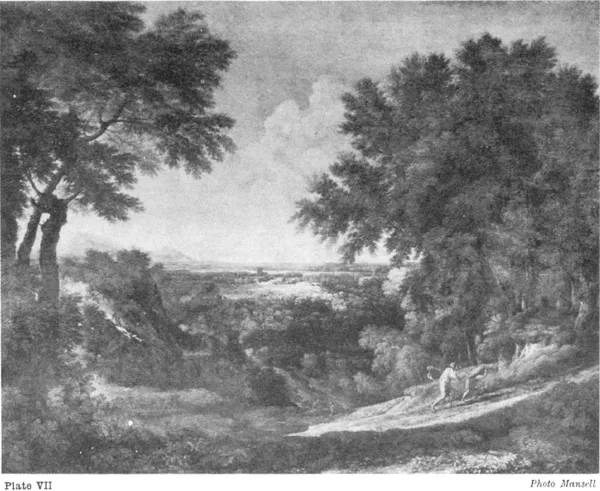
LANDSCAPE WITH FIGURES.GASPARD POUSSIN (NATIONAL GALLERY)
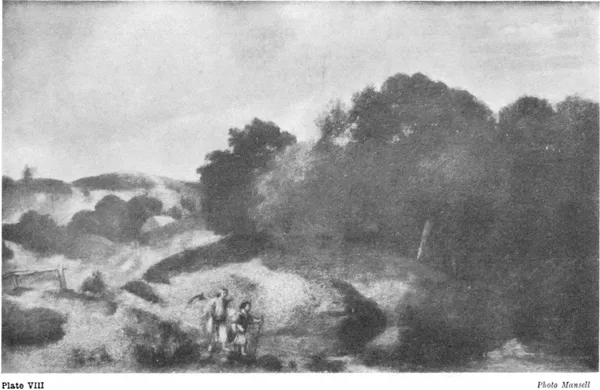
TOBIT AND THE ANGEL. REMBRANDT (OR SCHOOL OF) (NATIONAL GALLERY)
The treatment of this subject by Rembrandt and Salvatore should be compared as an extreme example of the predominating influence of temperament.
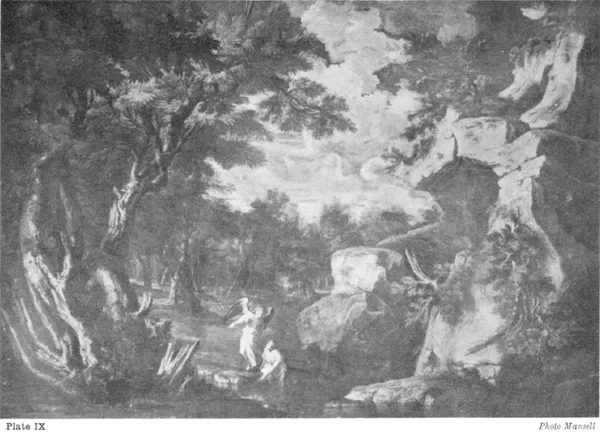
TOBIT AND THE ANGEL. SALVATORE ROSA (NATIONAL GALLERY)
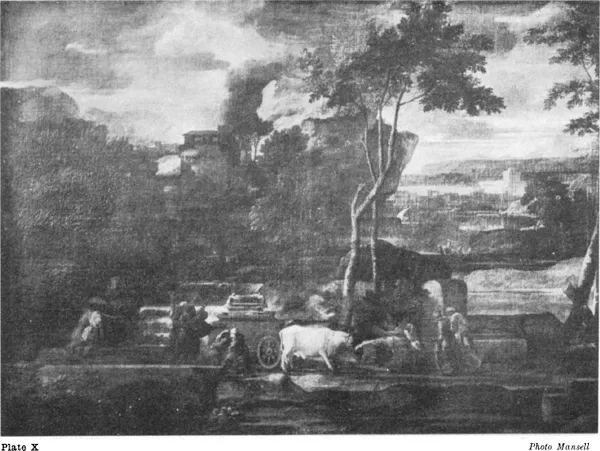
THE RETURN OF THE ARK FROM CAPTIVITY.SEBASTIEN BOURDON (...